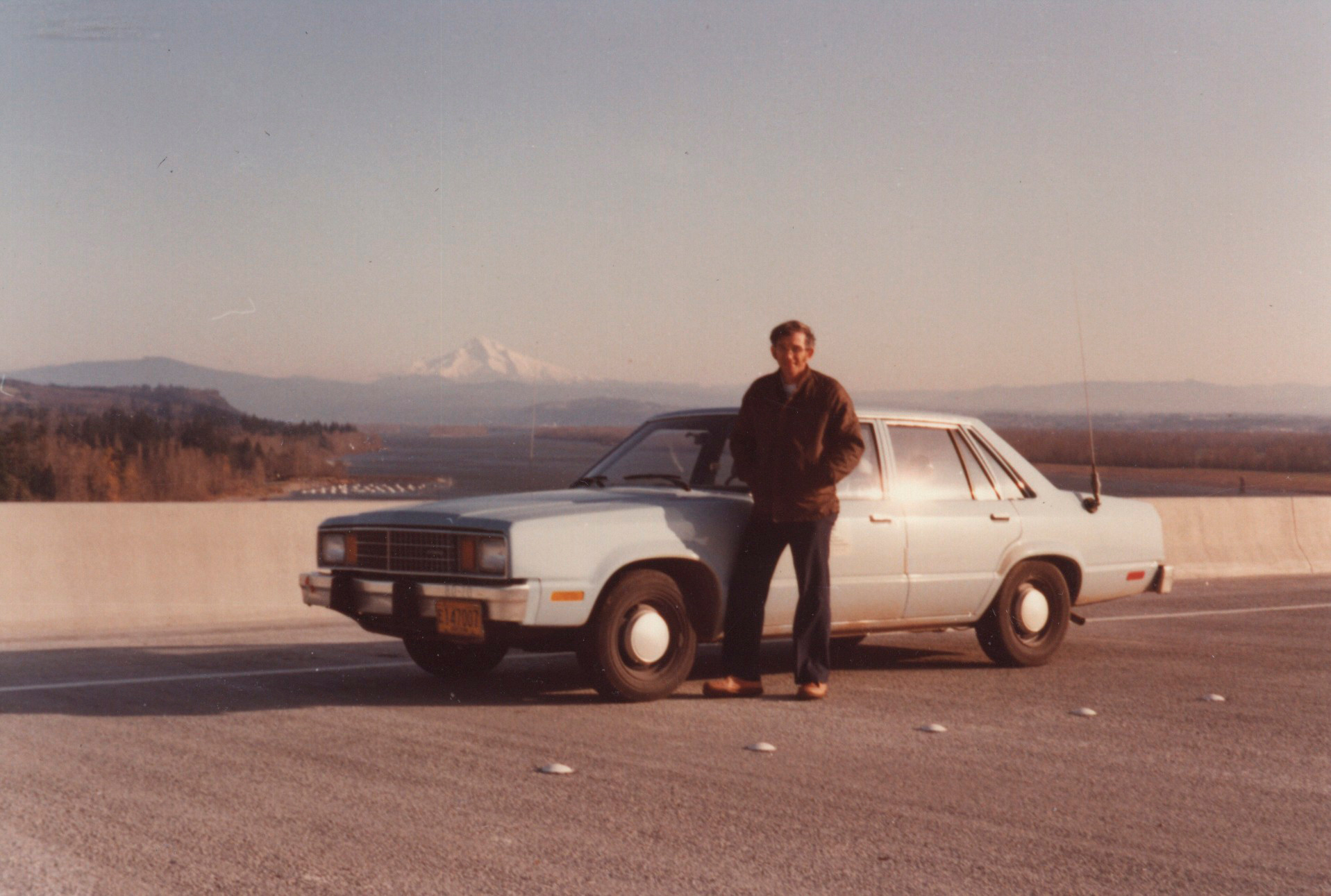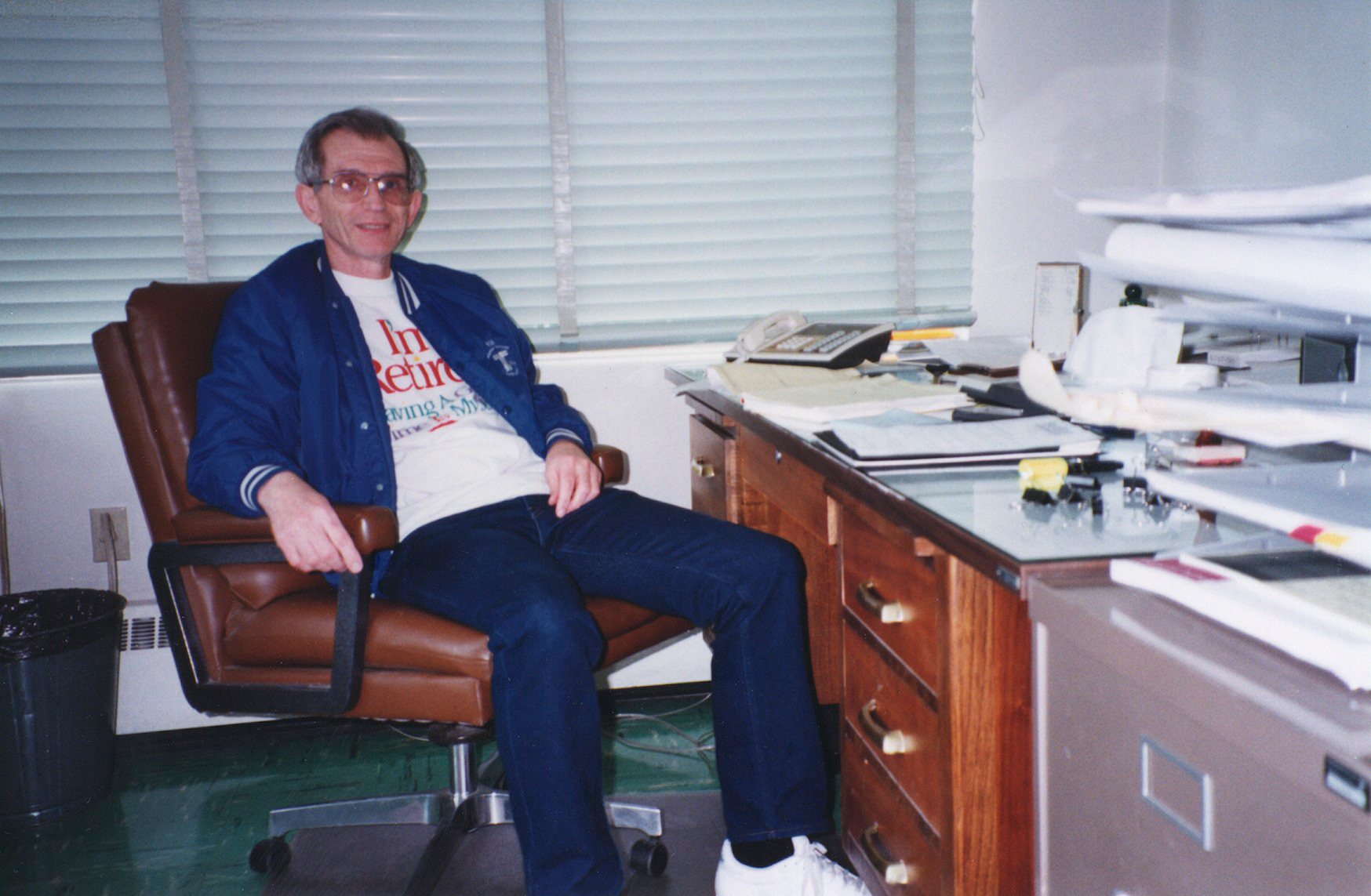By AMY CAVARETTA and ALLISON COLLINS
The Amazing Career of Ronald W. Failmezger, PE
Anyone working in or visiting the Portland office of Kittelson & Associates, Inc. is probably familiar with Ron. Crossing paths with him in the kitchen as he pours himself a cup of tea, he always gives a nod and a smile before quietly heading back to his office – a space filled to the brim with rolled-up plans, scales, pens, and pencils. He is a steadfast worker, devoutly spiritual, and thoughtful in every word he says. But he is not one to talk about himself – a fact that made the interviewing for this article all the more intriguing, given that stored in the man’s head is firsthand knowledge of the last 50 years of transportation planning in the state of Oregon. Many know that Ron has been with the company for several years – 18 to be exact. However, the majority of Kittelson employees are probably not aware that, prior to joining Kittelson, Ron spent more than three decades working with the Oregon Department of Transportation (ODOT), joining as a young man and one of only a handful of traffic engineers at ODOT, and leaving as the head of a department he built from the ground up.
Finding a Path
An Oregon native, Ronald (Ron) Failmezger was born just outside Portland in Oregon City. Though intelligent and interested in learning, Ron, a natural introvert, struggled early on with dyslexia. He found easy comprehension and enjoyment in comic books – which provided illustrations that allowed him to immerse himself in the stories without getting lost in the words. He spent an extra year in grade school, then enrolled at Portland State University with the intent to study business. Soon after beginning classes, Ron was approached by an acquaintance who suggested a career in civil engineering. As a senior at Oregon State University he found “the practicality of transportation” appealing, and after a week of traffic engineering spent on a roadway design channelization project in the civil engineering department, he found himself hooked on this area of study. Light on words and heavy on logic and analysis, Ron dedicated the rest of his studies to civil engineering. Upon graduation, he took a job with ODOT and never looked back.
 Through a three-month training program in the traffic group, Ron rapidly gained a wealth of knowledge about traffic operations, signals, signing, and striping. Transportation planning in the late 1950s differed greatly from the nuanced, complex, multimodal world we live in today. Back then, the automobile dominated the landscape completely. The interstate highway system, still relatively new at the time, presented a host of planning opportunities for new traffic engineers like Ron, particularly in the Salem/Portland area. However, there were plenty of other engineering needs in the state, and when eastern Oregon beckoned, Ron answered the call, moving to rural La Grande to become the head traffic engineer after only three years of working for ODOT.
Through a three-month training program in the traffic group, Ron rapidly gained a wealth of knowledge about traffic operations, signals, signing, and striping. Transportation planning in the late 1950s differed greatly from the nuanced, complex, multimodal world we live in today. Back then, the automobile dominated the landscape completely. The interstate highway system, still relatively new at the time, presented a host of planning opportunities for new traffic engineers like Ron, particularly in the Salem/Portland area. However, there were plenty of other engineering needs in the state, and when eastern Oregon beckoned, Ron answered the call, moving to rural La Grande to become the head traffic engineer after only three years of working for ODOT.
Arriving in La Grande, Ron was as “green as can be.” However, after a year spent dealing with district managers and project managers on various projects in the La Grande region, Ron found himself transformed. No longer a young kid fresh out of college, Ron Failmezger in just one year’s time found himself a leader. And when space opened up in the Portland region, Ron was one of the first to jump aboard. The transition from rural traffic engineering to a region with four large counties didn’t come without challenges. The city was in a heavy state of flux at the time. The Marquam Bridge hadn’t yet been constructed, and the 99E/W served as the only connector in a rapidly growing metro area. Ron’s workload was heavy, and after many years of handling a burgeoning workload on his own, working as one of the few traffic engineers for the Portland area, Ron was relieved to finally hire an assistant in 1977 .
One of Ron’s most entertaining memories with ODOT involved producing a motion picture using a helicopter. An article in The Oregonian, “Low Copter Counts Cars,” appearing October 5, 1961, chronicled the incident and included a picture of young Ron as part of a traffic count group in a state helicopter. The helicopter adventure caused quite a public disturbance, stopping traffic and leading to several complaints by residents and concerned parents of local schools. There was also the time that Ron accidentally knocked out power to one traffic signal—but best not to linger on that story too long….
Ron vividly remembers the historic events that challenged ODOT, such as the 1963 La Grande flood, the 1964 Columbus Day Storm, and the “Electrical Tower Terror.” He also drew a captivating portrait of the early days of bike/ped planning, recounting the construction of one of the area’s first dedicated bike lanes, located west of Portland on Farmington Road near Aloha. Some area residents took exception to the change to their road, and only a day after construction, the bike lane was vandalized and destroyed.
One of the innovations in traffic engineering that Ron was involved in was the “Green Wave,” based in Tigard. The Green Wave used traffic data to give consistent green cycles, and was one of the first coordinated signal systems in Oregon. Up until this time, all signals had been pre-timed, with no use of detection equipment. In the years following, engineers experimented with different methods, from treadles that used pressure for loops to the modern video detection systems. Starting in a career when signals had to be timed by hand and a yellow light could last 12 seconds, Ron has truly seen it all when it comes to signal timing mishaps and innovation.

Ron Failmezger
Ron on the Glen Jackson Bridge in Portland the day prior to its opening (1982)
“It Was a Different Time”
Looking back on transportation engineering in the 1950s, there are some marked differences from the industry today. When asked how many women worked as engineers back then, Ron touched his index finger to his thumb. “Zero.” Back then, it was all men, though he did note that the women working as secretaries in his division were often utilized for traffic counts. He also observed that women tended to be superior in conducting this work: “Women seemed to have more patience.”
Another striking difference between engineering then and now is the level of involvement and issues of litigation and policy. Back in the 1960s and 1970s, the ease of project work followed the schedule of the traffic engineer, and contractor. Often, Ron found himself going with a contractor to physically construct a left turn lane. There were no memos, reports, or traffic impact analyses required, and many more projects were able to be completed in short amounts of time. Ron comments on this change in the engineering industry as the inability to use engineering judgment. The excess of legal issues and the fear of being sued served to fundamentally alter the role of the traffic engineer.
However, it wasn’t only issues of legality that changed how ODOT does business. The whole idea of employing consultants was a foreign concept throughout the majority of Ron’s career with the department. Indeed, it wasn’t until the 1980s that much of the actual engineering work was made available to outside experts. This outsourcing of work to external civil engineers paved the way to creating our industry and made it possible for young industrious types like Wayne Kittelson to form consulting firms like Kittelson & Associates.
Ron also commented on a manual near and dear to the heart of Kittelson – The Highway Capacity Manual (HCM). Ron remembers the first edition as a “thin” document that he used frequently. In fact, he brought his tattered copy to our interview, saying with a smile that he still uses it on some of his projects. Ironically, given Kittelson’s work with the HCM, Ron commented that while the HCM has grown larger and more complex in subsequent editions, the overall effect of the solutions hasn’t changed. He said that large manuals such as the HCM that offer clear-cut guidance are positive when a beginning engineer doesn’t have as much experience, but can be a hindrance when experienced engineers see insight that might “violate” or contradict what the manual predicts.

Ron Failmezger
Ron at ODOT wearing his retirement shirt
Stepping from One World into Another
In the year prior to joining Kittelson, Ron wrote and self-published the Practical Manual on Access Management – a manual still in use today by several Oregon agencies. Of particular interest are some of his comments in the section titled “Dealing with Traffic Engineering Consultants,” in which he talks about his future employer.
This company does numerous traffic reports in the Portland area.… The traffic reports are very complete. In fact, they are so complete, sometimes it is difficult to get to the data that pertains to the concerns of the development and how the access will be handled. This consultant is very concerned about the developer’s position and will aggressively pursue their position. The traffic projections are accurate and the analysis is generally very good.
It is poetic justice that when the work that Ron dedicated his life to was ultimately outsourced from ODOT and the department he helped to create and define, he chose to follow it into the world of consulting and into a firm that he respected and admired. Ron has dedicated his professional life to transportation engineering, and his work continues to shape the landscape of the Portland Metro Area and the state. His contributions to the field of transportation are limitless and concrete – indeed, many reading this article navigate the city via arterials, freeways, on- and off-ramps, turn lanes, intersections, and traffic signals that Ron helped plan for and create.
So the next time you see Ron in the halls, as you share a nod and a smile, know that you are in the presence of one of the originals. And be humbled by his quiet dedication.
Read the companion article about Ron’s continuing impact – at the 60-year mark of his career! – on Kittelson’s emerging professional staff.
